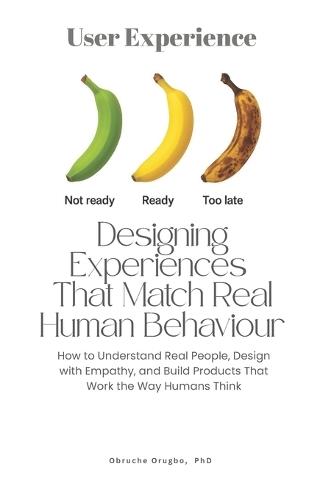Overview
Most products fail not because they lack features, funding, or talent-but because they fail to understand people. Designing Experiences That Match Real Human Behaviour is a practical and deeply human guide for anyone who creates digital products, services, or experiences. It bridges the space between psychology and design, showing how real people think, feel, decide, and behave when they interact with technology. This book is written for designers, researchers, product managers, and founders who want to move beyond guesswork. It shows how to uncover the hidden reasons behind user actions-the pauses, clicks, and choices that reveal what really matters. You'll learn how to see design through human eyes and create experiences that feel natural, intuitive, and genuinely useful. What You'll Learn Inside Each chapter offers a clear, engaging blend of behavioural theory and hands-on design application: Chapter 1: Understanding Human Behaviour in Design - Learn the difference between what users say and what they do. Discover how to observe real behaviour without bias and how to interpret it accurately. Chapter 2: From Assumptions to Evidence - Replace guesswork with research. Understand how to gather meaningful data, test ideas, and build evidence-driven design decisions. Chapter 3: The Psychology Behind Everyday Interactions - Explore how attention, memory, and emotion shape user decisions and how to design for the way people actually think. Chapter 4: Emotional Triggers and Decision-Making - Learn how to use emotion ethically in design to influence motivation, satisfaction, and trust. Chapter 5: Cognitive Load and Mental Shortcuts - Find out why simplicity matters and how to reduce the invisible effort that makes users quit. Chapter 6: Motivation, Frustration, and Expectation - Learn how expectations shape perception and why managing them can transform the user experience. Chapter 7: How Users Form Habits with Products - Understand how repetition, cues, and rewards turn one-time use into loyal behaviour. Chapter 8: Interpreting Non-Verbal User Cues - Go beyond words to read gestures, body language, and emotional responses during user testing. Chapter 9: Mapping Behavioural Journeys - Visualise how people move through an experience and where their emotions and decisions shift along the way. Chapter 10: Turning Observations into Actionable Insights - Learn how to translate research into practical recommendations that influence real design outcomes. Conclusion: The Future of Design in the Age of AI - See how empathy and human understanding remain essential even as technology evolves. Who Should Read It This book is for: UX designers who want to design with psychology and empathy Researchers who want to turn evidence into influence Product managers who need to align user goals with business outcomes Founders and decision-makers who want to create products people actually use and love Students who want a grounded introduction to human-centred design thinking Whether you're redesigning a digital service or launching a new product, this book will help you see users not as data points but as people-complex, emotional, and perfectly imperfect. If you want to design products that feel right the first time, this book will help you get there.
Full Product Details
Author: Obruche Orugbo, PhD
Publisher: Independently Published
Imprint: Independently Published
Dimensions:
Width: 15.20cm
, Height: 1.70cm
, Length: 22.90cm
Weight: 0.395kg
ISBN: 9798270510152
Pages: 294
Publication Date: 18 October 2025
Audience:
General/trade
,
General
Format: Paperback
Publisher's Status: Active
Availability: Available To Order

We have confirmation that this item is in stock with the supplier. It will be ordered in for you and dispatched immediately.



